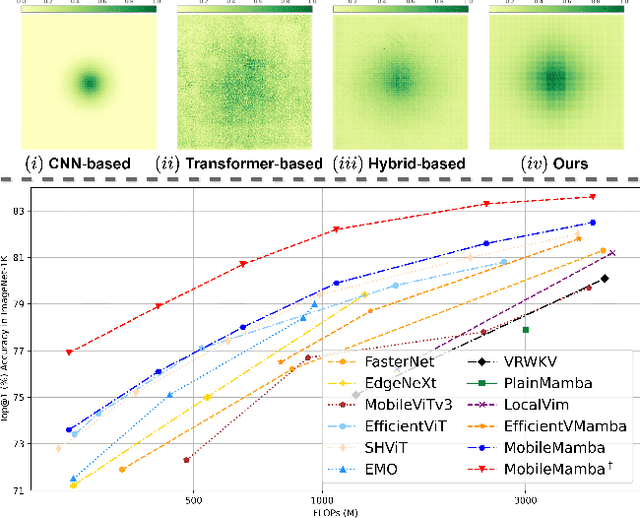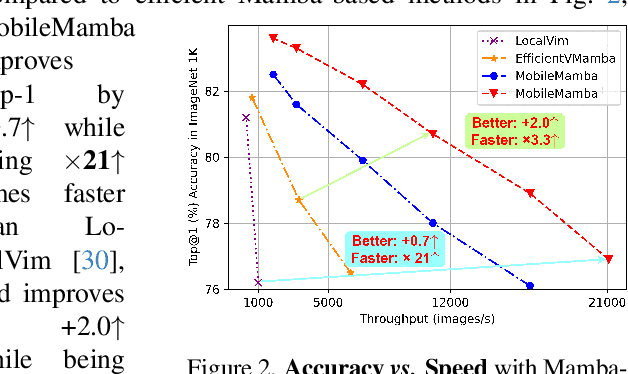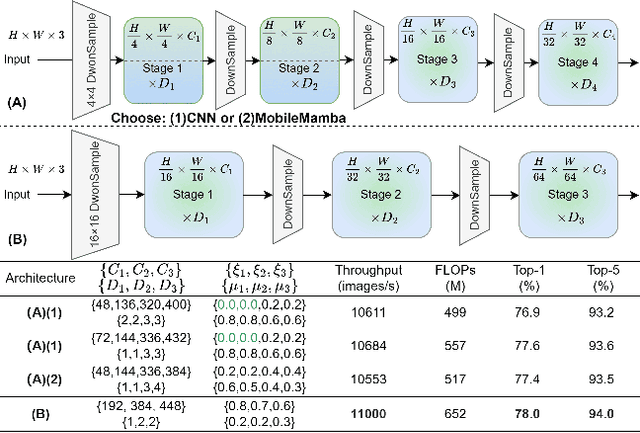Zhenye Gan
UniCombine: Unified Multi-Conditional Combination with Diffusion Transformer
Mar 12, 2025Abstract:With the rapid development of diffusion models in image generation, the demand for more powerful and flexible controllable frameworks is increasing. Although existing methods can guide generation beyond text prompts, the challenge of effectively combining multiple conditional inputs while maintaining consistency with all of them remains unsolved. To address this, we introduce UniCombine, a DiT-based multi-conditional controllable generative framework capable of handling any combination of conditions, including but not limited to text prompts, spatial maps, and subject images. Specifically, we introduce a novel Conditional MMDiT Attention mechanism and incorporate a trainable LoRA module to build both the training-free and training-based versions. Additionally, we propose a new pipeline to construct SubjectSpatial200K, the first dataset designed for multi-conditional generative tasks covering both the subject-driven and spatially-aligned conditions. Extensive experimental results on multi-conditional generation demonstrate the outstanding universality and powerful capability of our approach with state-of-the-art performance.
PixelPonder: Dynamic Patch Adaptation for Enhanced Multi-Conditional Text-to-Image Generation
Mar 09, 2025Abstract:Recent advances in diffusion-based text-to-image generation have demonstrated promising results through visual condition control. However, existing ControlNet-like methods struggle with compositional visual conditioning - simultaneously preserving semantic fidelity across multiple heterogeneous control signals while maintaining high visual quality, where they employ separate control branches that often introduce conflicting guidance during the denoising process, leading to structural distortions and artifacts in generated images. To address this issue, we present PixelPonder, a novel unified control framework, which allows for effective control of multiple visual conditions under a single control structure. Specifically, we design a patch-level adaptive condition selection mechanism that dynamically prioritizes spatially relevant control signals at the sub-region level, enabling precise local guidance without global interference. Additionally, a time-aware control injection scheme is deployed to modulate condition influence according to denoising timesteps, progressively transitioning from structural preservation to texture refinement and fully utilizing the control information from different categories to promote more harmonious image generation. Extensive experiments demonstrate that PixelPonder surpasses previous methods across different benchmark datasets, showing superior improvement in spatial alignment accuracy while maintaining high textual semantic consistency.
SoftPatch+: Fully Unsupervised Anomaly Classification and Segmentation
Dec 30, 2024



Abstract:Although mainstream unsupervised anomaly detection (AD) (including image-level classification and pixel-level segmentation)algorithms perform well in academic datasets, their performance is limited in practical application due to the ideal experimental setting of clean training data. Training with noisy data is an inevitable problem in real-world anomaly detection but is seldom discussed. This paper is the first to consider fully unsupervised industrial anomaly detection (i.e., unsupervised AD with noisy data). To solve this problem, we proposed memory-based unsupervised AD methods, SoftPatch and SoftPatch+, which efficiently denoise the data at the patch level. Noise discriminators are utilized to generate outlier scores for patch-level noise elimination before coreset construction. The scores are then stored in the memory bank to soften the anomaly detection boundary. Compared with existing methods, SoftPatch maintains a strong modeling ability of normal data and alleviates the overconfidence problem in coreset, and SoftPatch+ has more robust performance which is articularly useful in real-world industrial inspection scenarios with high levels of noise (from 10% to 40%). Comprehensive experiments conducted in diverse noise scenarios demonstrate that both SoftPatch and SoftPatch+ outperform the state-of-the-art AD methods on the MVTecAD, ViSA, and BTAD benchmarks. Furthermore, the performance of SoftPatch and SoftPatch+ is comparable to that of the noise-free methods in conventional unsupervised AD setting. The code of the proposed methods can be found at https://github.com/TencentYoutuResearch/AnomalyDetection-SoftPatch.
MobileMamba: Lightweight Multi-Receptive Visual Mamba Network
Nov 24, 2024



Abstract:Previous research on lightweight models has primarily focused on CNNs and Transformer-based designs. CNNs, with their local receptive fields, struggle to capture long-range dependencies, while Transformers, despite their global modeling capabilities, are limited by quadratic computational complexity in high-resolution scenarios. Recently, state-space models have gained popularity in the visual domain due to their linear computational complexity. Despite their low FLOPs, current lightweight Mamba-based models exhibit suboptimal throughput. In this work, we propose the MobileMamba framework, which balances efficiency and performance. We design a three-stage network to enhance inference speed significantly. At a fine-grained level, we introduce the Multi-Receptive Field Feature Interaction(MRFFI) module, comprising the Long-Range Wavelet Transform-Enhanced Mamba(WTE-Mamba), Efficient Multi-Kernel Depthwise Convolution(MK-DeConv), and Eliminate Redundant Identity components. This module integrates multi-receptive field information and enhances high-frequency detail extraction. Additionally, we employ training and testing strategies to further improve performance and efficiency. MobileMamba achieves up to 83.6% on Top-1, surpassing existing state-of-the-art methods which is maximum x21 faster than LocalVim on GPU. Extensive experiments on high-resolution downstream tasks demonstrate that MobileMamba surpasses current efficient models, achieving an optimal balance between speed and accuracy.
LLaVA-KD: A Framework of Distilling Multimodal Large Language Models
Oct 21, 2024Abstract:The success of Large Language Models (LLM) has led researchers to explore Multimodal Large Language Models (MLLM) for unified visual and linguistic understanding. However, the increasing model size and computational complexity of MLLM limit their use in resource-constrained environments. Small-scale MLLM (s-MLLM) aims to retain the capabilities of the large-scale model (l-MLLM) while reducing computational demands, but resulting in a significant decline in performance. To address the aforementioned issues, we propose a novel LLaVA-KD framework to transfer knowledge from l-MLLM to s-MLLM. Specifically, we introduce Multimodal Distillation (MDist) to minimize the divergence between the visual-textual output distributions of l-MLLM and s-MLLM, and Relation Distillation (RDist) to transfer l-MLLM's ability to model correlations between visual features. Additionally, we propose a three-stage training scheme to fully exploit the potential of s-MLLM: 1) Distilled Pre-Training to align visual-textual representations, 2) Supervised Fine-Tuning to equip the model with multimodal understanding, and 3) Distilled Fine-Tuning to further transfer l-MLLM capabilities. Our approach significantly improves performance without altering the small model's architecture. Extensive experiments and ablation studies validate the effectiveness of each proposed component. Code will be available at https://github.com/caiyuxuan1120/LLaVA-KD.
LLaVA-VSD: Large Language-and-Vision Assistant for Visual Spatial Description
Aug 09, 2024Abstract:Visual Spatial Description (VSD) aims to generate texts that describe the spatial relationships between objects within images. Traditional visual spatial relationship classification (VSRC) methods typically output the spatial relationship between two objects in an image, often neglecting world knowledge and lacking general language capabilities. In this paper, we propose a Large Language-and-Vision Assistant for Visual Spatial Description, named LLaVA-VSD, which is designed for the classification, description, and open-ended description of visual spatial relationships. Specifically, the model first constructs a VSD instruction-following dataset using given figure-caption pairs for the three tasks. It then employs LoRA to fine-tune a Large Language and Vision Assistant for VSD, which has 13 billion parameters and supports high-resolution images. Finally, a large language model (Qwen-2) is used to refine the generated sentences, enhancing their diversity and accuracy. LLaVA-VSD demonstrates excellent multimodal conversational capabilities and can follow open-ended instructions to assist with inquiries about object relationships in images.
PSPU: Enhanced Positive and Unlabeled Learning by Leveraging Pseudo Supervision
Jul 09, 2024



Abstract:Positive and Unlabeled (PU) learning, a binary classification model trained with only positive and unlabeled data, generally suffers from overfitted risk estimation due to inconsistent data distributions. To address this, we introduce a pseudo-supervised PU learning framework (PSPU), in which we train the PU model first, use it to gather confident samples for the pseudo supervision, and then apply these supervision to correct the PU model's weights by leveraging non-PU objectives. We also incorporate an additional consistency loss to mitigate noisy sample effects. Our PSPU outperforms recent PU learning methods significantly on MNIST, CIFAR-10, CIFAR-100 in both balanced and imbalanced settings, and enjoys competitive performance on MVTecAD for industrial anomaly detection.
ADer: A Comprehensive Benchmark for Multi-class Visual Anomaly Detection
Jun 06, 2024Abstract:Visual anomaly detection aims to identify anomalous regions in images through unsupervised learning paradigms, with increasing application demand and value in fields such as industrial inspection and medical lesion detection. Despite significant progress in recent years, there is a lack of comprehensive benchmarks to adequately evaluate the performance of various mainstream methods across different datasets under the practical multi-class setting. The absence of standardized experimental setups can lead to potential biases in training epochs, resolution, and metric results, resulting in erroneous conclusions. This paper addresses this issue by proposing a comprehensive visual anomaly detection benchmark, \textbf{\textit{ADer}}, which is a modular framework that is highly extensible for new methods. The benchmark includes multiple datasets from industrial and medical domains, implementing fifteen state-of-the-art methods and nine comprehensive metrics. Additionally, we have open-sourced the GPU-assisted \href{https://pypi.org/project/ADEval}{ADEval} package to address the slow evaluation problem of metrics like time-consuming mAU-PRO on large-scale data, significantly reducing evaluation time by more than \textit{1000-fold}. Through extensive experimental results, we objectively reveal the strengths and weaknesses of different methods and provide insights into the challenges and future directions of multi-class visual anomaly detection. We hope that \textbf{\textit{ADer}} will become a valuable resource for researchers and practitioners in the field, promoting the development of more robust and generalizable anomaly detection systems. Full codes have been attached in Appendix and open-sourced at \url{https://github.com/zhangzjn/ader}.
Efficient Multimodal Large Language Models: A Survey
May 17, 2024



Abstract:In the past year, Multimodal Large Language Models (MLLMs) have demonstrated remarkable performance in tasks such as visual question answering, visual understanding and reasoning. However, the extensive model size and high training and inference costs have hindered the widespread application of MLLMs in academia and industry. Thus, studying efficient and lightweight MLLMs has enormous potential, especially in edge computing scenarios. In this survey, we provide a comprehensive and systematic review of the current state of efficient MLLMs. Specifically, we summarize the timeline of representative efficient MLLMs, research state of efficient structures and strategies, and the applications. Finally, we discuss the limitations of current efficient MLLM research and promising future directions. Please refer to our GitHub repository for more details: https://github.com/lijiannuist/Efficient-Multimodal-LLMs-Survey.
MambaAD: Exploring State Space Models for Multi-class Unsupervised Anomaly Detection
Apr 14, 2024



Abstract:Recent advancements in anomaly detection have seen the efficacy of CNN- and transformer-based approaches. However, CNNs struggle with long-range dependencies, while transformers are burdened by quadratic computational complexity. Mamba-based models, with their superior long-range modeling and linear efficiency, have garnered substantial attention. This study pioneers the application of Mamba to multi-class unsupervised anomaly detection, presenting MambaAD, which consists of a pre-trained encoder and a Mamba decoder featuring (Locality-Enhanced State Space) LSS modules at multi-scales. The proposed LSS module, integrating parallel cascaded (Hybrid State Space) HSS blocks and multi-kernel convolutions operations, effectively captures both long-range and local information. The HSS block, utilizing (Hybrid Scanning) HS encoders, encodes feature maps into five scanning methods and eight directions, thereby strengthening global connections through the (State Space Model) SSM. The use of Hilbert scanning and eight directions significantly improves feature sequence modeling. Comprehensive experiments on six diverse anomaly detection datasets and seven metrics demonstrate state-of-the-art performance, substantiating the method's effectiveness.
 Add to Chrome
Add to Chrome Add to Firefox
Add to Firefox Add to Edge
Add to Edge